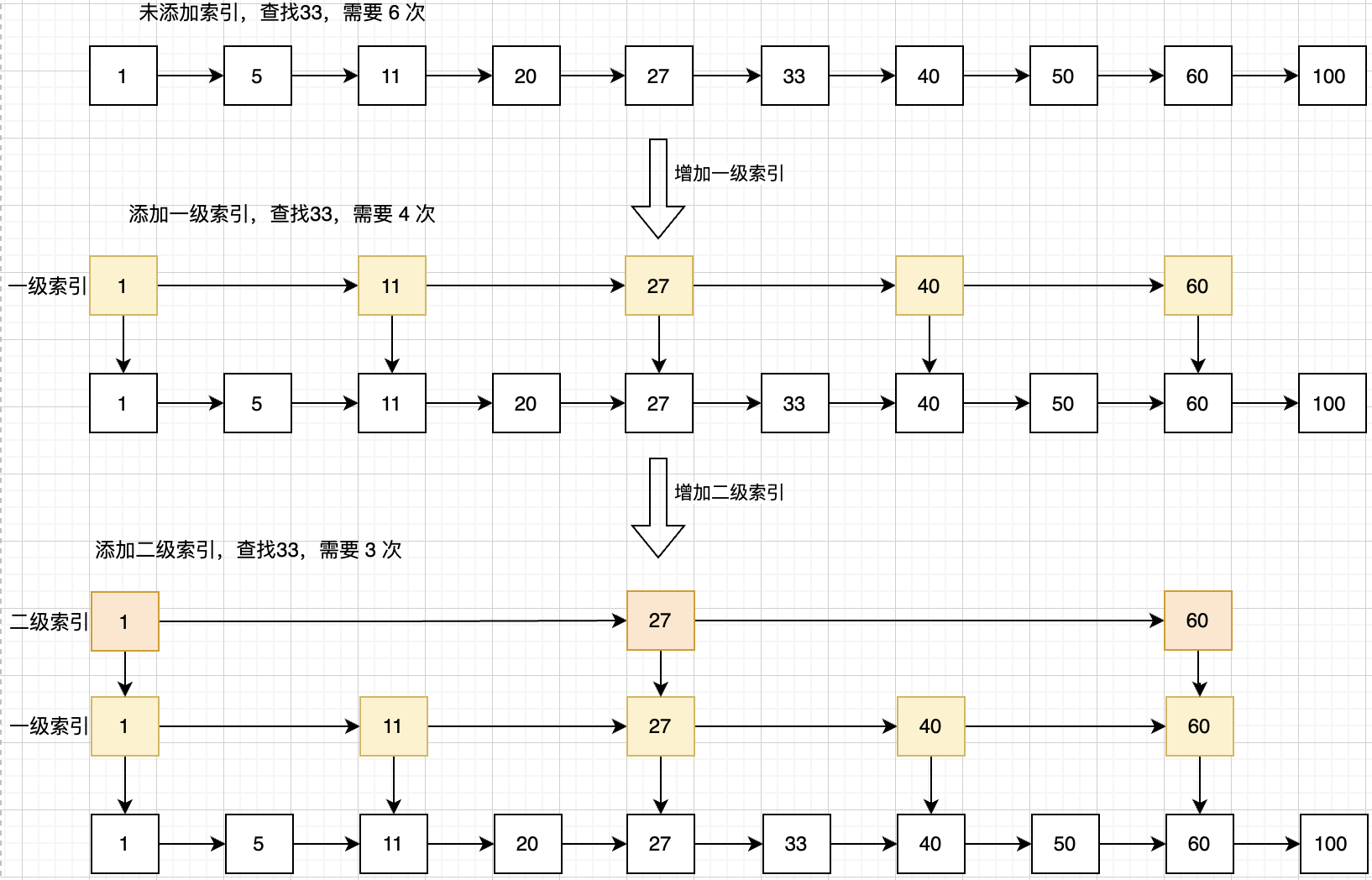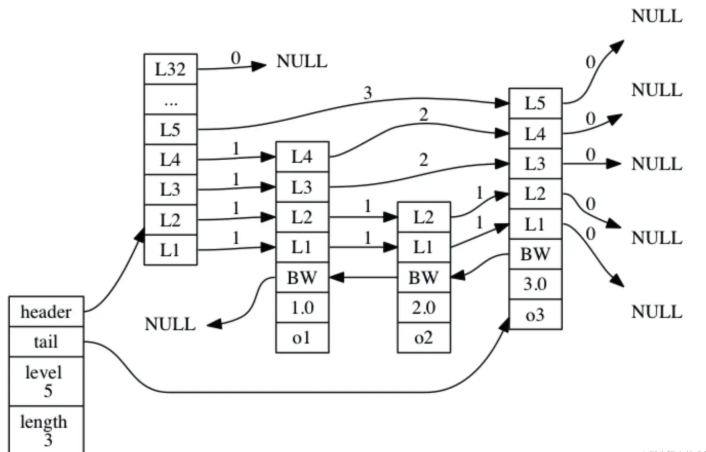
01 矩阵
二叉树
红黑树
压缩列表(ziplist)
ziplist是一个经过特殊编码的双向链表,它的设计目标是节省内存。它可以存储字符串或者整数。其中整数是按二进制进行编码的,而不是字符串序列。
它能以O(1)的时间复杂度在列表的两端进行push和pop操作。但是由于每个操作都 u 要对ziplist所使用的内存进行重新分配,所以实际操作的复杂度与ziplist占用的内存大小有关。
在redis中,有序集合、散列和列表都直接或间接使用了压缩列表。当有序集合或散列的元素个数较少,并且元素都是短字符串时,redis便会使用压缩列表作为底层数据存储。redis的列表使用的快速链表数据结构进行存储,而快速链表就是双向链表与压缩列表的组合。
总的来说,ziplist有如下特性:
- 本质上是一个字节数组
- 是redis为了节约内存而设计的一种线性结构
- 可以包含多个元素,每个元素可以是一个字节数组或一个整数
在redis中,压缩列表主要由 5 部分组成:
| 属性 | 类型 | 长度 | 用途 |
|---|---|---|---|
| zlbytes | unit32_t | 4字节 | 记录整个压缩列表占用的内存字节数:在对压缩列表进行内存重分配,或者计算 zlend 的位置时使用。 |
| zltail | unit32_t | 4字节 | 记录压缩列表表尾节点距离压缩列表的起始地址有多少字节:通过这个偏移量,程序无需遍历整个压缩列表就可以确定表尾节点的地址。 |
| zllen | unit16_t | 2字节 | 记录了压缩列表包含的节点数量,当这个属性的值小于 UINT16_MAX(65535)时,这个属性的值就是压缩列表包含节点的数量;当这个值等于 UINT16_MAX 时,节点的真实数量需要遍历整个压缩列表才能计算得出。 |
| entry | 列表节点 | 不定 | 压缩列表包含的各个节点 |
| zlend | unit8_t | 1字节 | 特殊值 0xFF(十进制 255),用于标记压缩列表的末端。 |

如上图所示,这是一个包含三个节点的压缩列表的示例:
- zlbytes 属性的值为 0x50(十进制 80),表示压缩列表的总长为 80 字节。
- zltail 属性的值为 0x3c(十进制 60),这表示如果我们有一个指向压缩列表起始地址的指针 p,那么只要用指针 p 加上偏移量 60,就可以计算出表尾节点 entry3 的地址。
- zllen 属性的值为 0x3(十进制 3),表示压缩列表包含三个节点。
对于压缩列表而言,每个entry的数据结构又包含三部分,分别是:
- previous_entry_length:表示前一个元素的长度,占 1 字节或者 5 字节
- 当前一个元素的长度小于 254 字节时,使用 1 字节表示记录上一个元素长度
- 当前一个元素的长度大于或等于 254 字节时,用 5 字节表示。其中第一个字节固定为0xFE(十进制为 254),后 4 字节才是上一个元素的真正长度
- encoding:当前元素的编码,记录节点的content字段锁保存的数据的类型以及长度,它的类型一共有两种,分别是字节数组和整数。它的长度可能为 1字节、2 字节或者 5 字节
- content:用于保存当前节点的内容,节点内容类型和长度由encoding决定
encoding内容说明
当content要存储的数据是字节数组时:
| 内容 | 长度 | 描述 |
|---|---|---|
| 00 bbbbbb | 1字节 | 最大长度为 63 的字节数组 |
| 01 bbbbbb xxxxxxxx | 2字节|最大长度 2^14-1的字节数组 | |
| 10 ________ aaaaaaaa bbbbbbbb cccccccc dddddddd | 5字节 | 最大长度2^32-1的字节数组 |
当content要存储的数据是整数时:
| 内容 | 长度 | 描述 |
|---|---|---|
| 11000000 | 1字节 | int16_t类型整数(2字节) |
| 11010000 | 1字节 | int32_t类型整数(4字节) |
| 11100000 | 1字节 | int64_t类型整数(8字节) |
| 11110000 | 1字节 | 24位有符号整数(3字节) |
| 11111110 | 1字节 | 8 位有符号整数(1字节) |
| 1111xxxx | 1字节 | 用xxxx思维表示内容,此时将不在需要content |
| 11111111 | 1字节 | 表示压缩列表的结束 |
跳跃表(zSkiplist)
跳跃表即跳表,是一个可以快速查询有序连续元素的数据链表。跳表的平均查找和插入时间复杂度都是O(long n),优于普通队列的O(n)。
它最大的优势是原理简单、容易实现、方便扩展、效率更高。因此在一些热门的项目中用来替代平衡树,它最典型的用途就是作为redis中的zset的基础数据类型。
跳表是在链表的基础上,增加了多级索引,通过索引位置的几个跳转,实现数据的快速定位。

由上图可见,针对存储的数据个数,增加多级索引,查找数据时,按照多级索引,一级一级地以此查找,从而缩短查询的时间,当定位到原始链表后,如果没有查找到对应的值,那么也可以说明这个有序链表中不存在这个元素。
跳表查询的时间复杂度计算:
n/2、n/4、n/8、第 k 级索引结点的个数就是 n/(2^k)
假设索引有 h 级,最高级的索引有 2 个结点。n/(2^h) = 2,从而求得 h = log2(n)-1

举一个例子,跳表在查询的时候,假设索引的高度:logn,每层索引遍历的结点个数:3,假设要走到第 8 个节点。
每层要遍历的元素总共是3个,所以这里的话 log2 8 的话,就是它的时间复杂度。最后的话得出证明出来:时间复杂度为log2n。也就是从最朴素的原始链表的话,它的 O(n) 的时间复杂度降到 log2n 的时间复杂度。这已经是一个很大的改进了。假设是1024的话,你会发现原始链表要查1024次最后得到这个元素,那么这里的话就只需要查(2的10次方是1024次)十次这样一个数量级。
跳表的空间复杂度计算:
假设它的长度为 n,然后按照之前的例子,每两个节点抽一个做成一个索引的话,那么它的一级索引为二分之 n 对吧。最后如下:
原始链表大小为 n,每 2 个结点抽 1 个,每层索引的结点数: n/2,n/4,n/8,……,8,4,2
原始链表大小为 n,每 3 个结点抽 1 个,每层索引的结点数: n/3,n/9,n/27,……,9,3,1
空间复杂度是 O(n)
跳表的构成

从图中可以看到, 跳跃表主要由以下部分构成:
- 表头(head):负责维护跳跃表的节点指针。
- 跳跃表节点:保存着元素值,以及多个层。
- 层:保存着指向其他元素的指针。高层的指针越过的元素数量大于等于低层的指针,为了提高查找的效率,程序总是从高层先开始访问,然后随着元素值范围的缩小,慢慢降低层次。
- 表尾:全部由 NULL 组成,表示跳跃表的末尾。
用java实现跳表
1 | import java.util.concurrent.ThreadLocalRandom; |
redis跳表的实现
Redis 的跳跃表由 redis.h/zskiplistNode 和 redis.h/zskiplist 两个结构定义, 其中 zskiplistNode 结构用于表示跳跃表节点, 而 zskiplist 结构则用于保存跳跃表节点的相关信息, 比如节点的数量, 以及指向表头节点和表尾节点的指针, 等等。

上图展示了一个跳跃表示例,位于图片最左边的示 zskiplist 结构,该结构包含以下属性:
- header :指向跳跃表的表头节点。
- tail :指向跳跃表的表尾节点。
- level :记录目前跳跃表内,层数最大的那个节点的层数(表头节点的层数不计算在内)。
- length :记录跳跃表的长度,也即是,跳跃表目前包含节点的数量(表头节点不计算在内)。
位于 zskiplist 结构右方的是四个 zskiplistNode 结构, 该结构包含以下属性:
- 层(level):节点中用 L1 、 L2 、 L3 等字样标记节点的各个层, L1 代表第一层, L2 代表第二层,以此类推。每个层都带有两个属性:前进指针和跨度。前进指针用于访问位于表尾方向的其他节点,而跨度则记录了前进指针所指向节点和当前节点的距离。在上面的图片中,连线上带有数字的箭头就代表前进指针,而那个数字就是跨度。当程序从表头向表尾进行遍历时,访问会沿着层的前进指针进行。
- 后退(backward)指针:节点中用 BW 字样标记节点的后退指针,它指向位于当前节点的前一个节点。后退指针在程序从表尾向表头遍历时使用。
- 分值(score):各个节点中的 1.0 、 2.0 和 3.0 是节点所保存的分值。在跳跃表中,节点按各自所保存的分值从小到大排列。
- 成员对象(obj):各个节点中的 o1 、 o2 和 o3 是节点所保存的成员对象。




